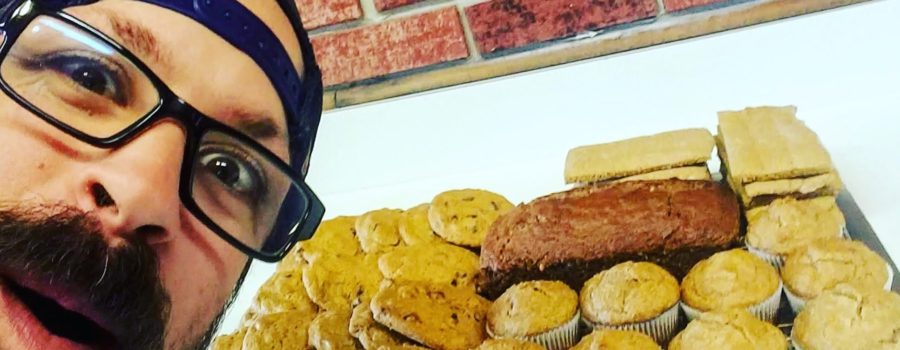We are grateful to be able to interact with many friends and customers throughout the year. A common conversation with many revolves around baking with the stone-milled whole flours from our farm. Many folks have commented that upon opening a package of our flour that it’s noticeably different (in a good way!) from other flours they’ve baked with in terms of texture, flavor, and taste. This is largely a function of the heritage stone mill that we use and our milling process. While modern flour is milled on large roller mills or industrial stone mills and may be further sifted or separated, our farm’s small stone mill creates a unique, full-bodied whole flour reminiscent of the whole-grain heritage of years gone by. This has been why some many of our customers come back for more, as baking with our organic whole flour often results in sweet and savory memories of our past as well as fun new twists on our favorite modern recipes. So, in line with many of the baking conversations that I have with family, friends, and customers, here are a few of my own reflections on baking with our delicious, whole grain flours.
Know Your Purpose
Baking with any whole grain flour creates a few wrinkles compared to commercially processed flour that folks often find on the store shelf. Part of the purpose of that commercial processing is to make flour that is easy to work with and has a long shelf life; it’s not necessarily for the nutrition factor that is usually associated with whole grains. So, while that flour may turn out the most perfect-looking cookie you’ve ever seen, the flour is just a medium to deliver yummy chocolate chips. One of my main purposes is to bake with flour that is nourishing. So, while I may have to tweak my recipe or technique to achieve that same picture-perfect cookie, I know regardless of the outcome that cookie is going to be full of the whole grain goodness I want. Know your purpose.

Whole Grain Honey Dandelion Cookies
Walk Before You Run
This is true in so many facets of life, and it has certainly been true in my own baking adventure. When I started baking with whole grains my initial assumption was that if I’m going down that road then I better get to it. I started taking recipes and going 100% whole grain flour. This led to some interesting kitchen experiences and plenty of frustration. Look, I am certainly not a professional baker; I’m venturing to say most of our customers aren’t either. Once I accepted this I saw that there was some middle ground here, and I started baking with a 50/50 commercial flour and whole grain flour mix. This resulted in more consistent and desirable baking, but more importantly I was able to better understand how the addition of whole grain flour changes the baking process. When you’re starting out with a new whole grain flour, walk before you run.

Switch It Up
There will come a time where you are determined to crank out a certain type of whole grain bread or baked good and despite your best efforts (and maybe a few choice words) it’s just not working. Don’t be afraid to switch it up and fall back to a flour that you’re more comfortable with. This gives you the opportunity to check your methods and techniques. Once you reestablish your confidence in the recipe, then start increasing your whole grain flour percentage to find your sweet spot. Don’t be afraid to switch it up every now and then.

Whole Wheat Chocolate Chip Cookies
Delayed Fermentation
When I started baking bread with whole grain flours I quickly began to realize that this was a big pool that I jumped in and if I wanted to really get comfortable with whole grain flours then I should probably educate myself. That is when I came across a book from Peter Reinhart (no relation despite the fact that I also have a brother Peter, funny world). Titled, “Whole Grain Breads, New Techniques, Extraordinary Flavor”, it describes a process called delayed fermentation that has been really helpful to me in turning our whole grain flours into some really delicious bakes. While it’s certainly not the only helpful or interesting book out there (check out Mother Grains by Roxanna Jullapat, another favorite!), if you’re making the investment to incorporate whole grain flours into your baking then reach out and learn from others about new or different baking styles, such as delayed fermentation.

Enjoy the Ride
Look, you’re going to have really good bakes and some that don’t quite meet expectations. If things really go sideways, take a step back, have a few laughs, and give it another go. Either way, when baking with whole grains whatever comes out of the oven is going to have some thought, love, and nutrition. Recently I was on a fishing trip with some buddies and was grateful to have the opportunity to bake pizzas for them one night. While they were going back for seconds and thirds, I thought about how thankful I was to be able to make them good, nutritious food rather than just some meat and veggies on a blank, sterile dough made from processed flour. So, have fun with your whole grain baking journey, be adventurous, spread a little love through food, and by all means enjoy the ride.

I love pizza…a lot! Check out our Pizza Crust Recipe
If you’re looking to get some whole grain flour to stock your pantry for the holiday season, check out our fresh, stone-milled flours – Soft Red Whole Wheat, Hard Red Whole Wheat, Spelt, Buckwheat, Cornmeal.







Leave a Reply
Your email is safe with us.